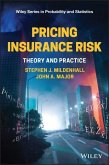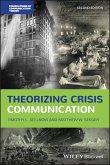An authoritative compendium of new research findings and case studies in the application of communication theory during catastrophic events
Communicating Science in Times of Crisis: Communication and Catastrophic Events addresses the practical application and research implications of communication theory in the context of man-made and natural catastrophes. Bringing together contributions by leading experts in crisis management and strategic communication, this timely collection of resources links scientific issues with public policy while discussing the challenges and opportunities for using communication to manage extreme events in the evolving media landscape of the 21st century.
In this second volume of the Wiley-Blackwell Communicating Science in Times of Crises series, 15 substantial chapters explore a varied range of catastrophic conditions, such as mass violence incidents, disease outbreaks, catastrophic mudslides, cascading and simultaneous disasters, extreme weather events, diffusion of misinformation during crises, students traveling internationally during a global health crisis, and more. Each chapter focuses on a particular issue or concern, revealing the difficult choices that confront academics and practitioners across communication disciplines and presenting original frameworks and models alongside ongoing research programs.
_ Discusses approaches for balancing scientific findings with social and cultural issues
_ Highlights the ability of legacy and digital media to facilitate science in mitigating the effects of adverse events
_ Examines the ethical repercussions of communication during unfolding and unpredictable events
_ Addresses the use of social media communication during a crisis and navigating an increasingly media-savvy society with multiple levels of science literacy
_ Covers key theoretical and practical aspects of the associated fields of risk management and crisis management
Available as a standalone book or as part of a two-volume set, Communicating Science in Times of Crisis: Communication and Catastrophic Events is essential reading for scholars, researchers, practitioners, and advanced students in the fields of crisis communication, risk and emergency management, disaster studies, policy management, social media communication, and healthcare communication.
Hinweis: Dieser Artikel kann nur an eine deutsche Lieferadresse ausgeliefert werden.
Communicating Science in Times of Crisis: Communication and Catastrophic Events addresses the practical application and research implications of communication theory in the context of man-made and natural catastrophes. Bringing together contributions by leading experts in crisis management and strategic communication, this timely collection of resources links scientific issues with public policy while discussing the challenges and opportunities for using communication to manage extreme events in the evolving media landscape of the 21st century.
In this second volume of the Wiley-Blackwell Communicating Science in Times of Crises series, 15 substantial chapters explore a varied range of catastrophic conditions, such as mass violence incidents, disease outbreaks, catastrophic mudslides, cascading and simultaneous disasters, extreme weather events, diffusion of misinformation during crises, students traveling internationally during a global health crisis, and more. Each chapter focuses on a particular issue or concern, revealing the difficult choices that confront academics and practitioners across communication disciplines and presenting original frameworks and models alongside ongoing research programs.
_ Discusses approaches for balancing scientific findings with social and cultural issues
_ Highlights the ability of legacy and digital media to facilitate science in mitigating the effects of adverse events
_ Examines the ethical repercussions of communication during unfolding and unpredictable events
_ Addresses the use of social media communication during a crisis and navigating an increasingly media-savvy society with multiple levels of science literacy
_ Covers key theoretical and practical aspects of the associated fields of risk management and crisis management
Available as a standalone book or as part of a two-volume set, Communicating Science in Times of Crisis: Communication and Catastrophic Events is essential reading for scholars, researchers, practitioners, and advanced students in the fields of crisis communication, risk and emergency management, disaster studies, policy management, social media communication, and healthcare communication.
Hinweis: Dieser Artikel kann nur an eine deutsche Lieferadresse ausgeliefert werden.








